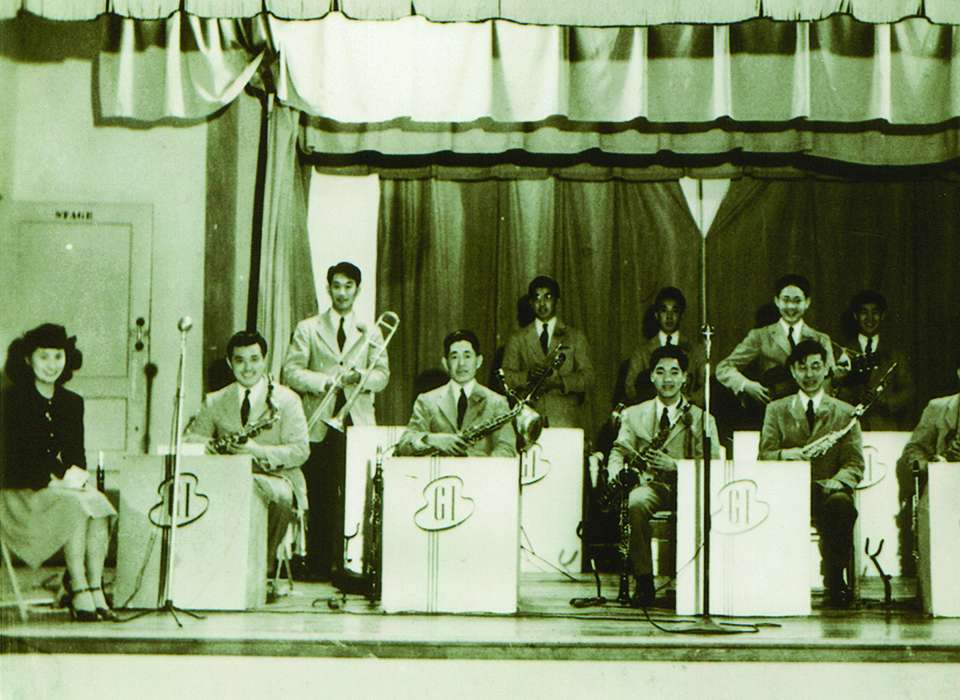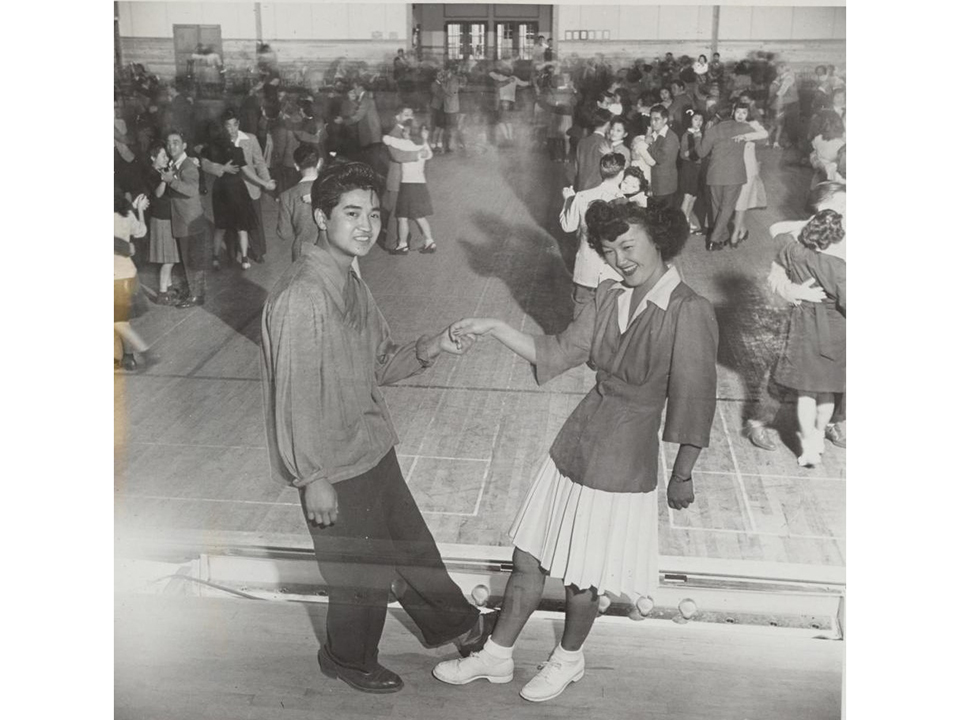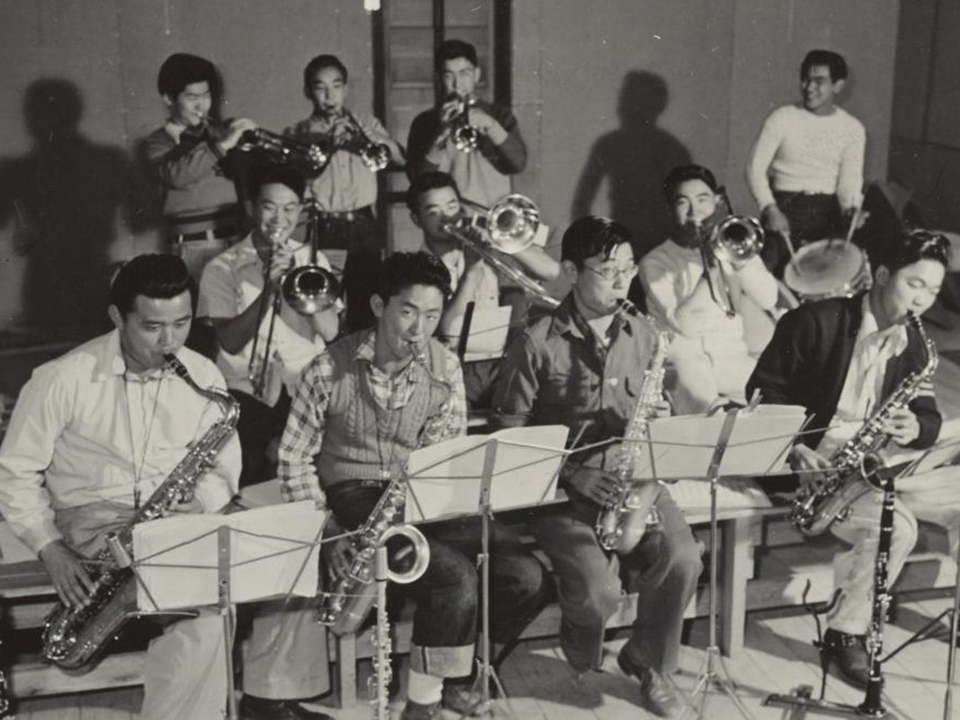Top Image: The George Igawa Orchestra with Joy on the far left. Courtesy of the Heart Mountain Wyoming Foundation (HMWF) Collection.
Heart Mountain was one of 10 incarceration camps for Japanese Americans whose creation was based on Roosevelt’s Executive Order 9066, signed into law on February 19, 1942. The law was a direct response to the Pearl Harbor attack and growing fear surrounding questions about loyalty of Japanese Americans to their American homeland. Deemed a “military necessity,” about 120,000 individuals of Japanese descent, most of them American citizens, were forced to leave their homes and lives behind and start a process of captive relocation into one of the camps that had hastily been built in remote areas across California, Arizona, Wyoming, Colorado, Utah, and Arkansas.
The Heart Mountain War Relocation Center in northwestern Wyoming was located between the towns of Cody and Powell where it housed up to 11,000 people at any given time in 650 military-style barracks. The Center also included administrative buildings, a hospital, educational and utility facilities, all surrounded by barbed-wire fencing and guard towers. The camp was hastily put together in about two months before the first incarcerees arrived in August 1942.
In the face of an unjust and forced relocation, many of those held tried to create a sense of normalcy for themselves and their families, and find a way to endure the situation in which they found themselves. Images of Heart Mountain show daily life in a prison camp, where the incarcerees tried to lead as ‘normal’ a life as possible: Individuals are seen working, going to school, gathering socially.… Most interesting are images of young Japanese Americans dancing, proudly showing off their jitterbug moves in bobby socks and fashionably-cut outfits of the day.
Tubbie Kunimatsu, the orchestra’s sometime vocalist, demonstrates a jitterbug with Laverne Kurahara at a Heart Mountain High School dance. Photo by Hikaru Iwasaki, Courtesy of UC Berkeley.
Music played a crucial part of life in the confinement centers. Music was an uplifting force, now and then, whether in informal gatherings among families and friends or in more organized concerts, school dances, or theater performances. In that, Heart Mountain was not alone. At all 10 centers, incarcerees formed bands and made music together. The administrations tended to support such cultural events and musical endeavors as a means to show the outside world how “humane” their fellow Americans were treated, despite their forced relocation. Certain bands were even sponsored by the War Relocation Authority as a means to further “Americanize” their Japanese American audience members. In some ways, the music and dancing to current swing music offered the incarcerated population an option to express and affirm their American identities. It was a means, especially for younger people to say, in effect, ‘listen, we love the same things you love! We may look different, but really we are just like you!’
At Heart Mountain, the George Igawa Orchestra, a big band comprised of a mix of professional and amateur musicians, became so popular as a dance band that it had an impact far beyond the confines of the center.
George Igawa was already a well-established musician in Los Angeles by the time he was forced to relocate. He had been the leader of a band called the ‘Sho Tokyans’ which gained moderate success playing swing tunes and standards of the era for Japanese American communities along the West Coast. They toured Japan before the war, taking American music abroad. Like every other Japanese American forced to leave their home, bandleader Igawa was only allowed to bring what he could carry. For him, that meant his musical instruments. While in the Pomona CA “assembly” center, waiting for the next step in the relocation nightmare, he scouted other musicians who had also carried their instruments with them. With these fellow players, Igawa formed a swing band called “The Pomonans.”
As the members of the Pomonans were transferred to Heart Mountain, he transformed his band yet again. The new “G(eorge) I(gawa) Orchestra” held talent shows and showcases to find new band members, announcing in the local newspaper that they recruited both semi-professional musicians, as well as amateurs, and even high schoolers if they showed talent. The newly formed GI Orchestra boasted, at its height, up to 19 members!
George and his band played hits of the day as well as Igawa’s own arrangements, drawing on a mix of American swing and Japanese tunes and traditions. The band’s daily practice paid off. Their music was, as one article put it, “directly in the groove.” Members of the band even received a minor salary paid by the center’s recreation department. This must certainly have been an incentive, however small, as playing music was considered unskilled labor. However, the most memorable experience that playing in the George Igawa Orchestra offered its band members was not the financial payoff. Within a short time, the dances and other events where the band appeared became so well known that word spread beyond the confines of the center, allowing them to travel outside the barbed wire and perform their music across Wyoming.
Jimmie Akiya, the drummer for the big band, recalled later that the first time he left the center was with the orchestra. He remembers that “A war bond rally in Powell was the first outside stint we had. It was amazing how they reacted.” Other newspaper articles and oral histories show similar reactions. The band was highly successful and beloved outside of Heart Mountain. The small towns and cities would welcome them with open arms, on at least one occasion providing them with a welcome feast of venison—not something the mess hall at Heart Mountain offered as an option to the incarcerees. The band would play high school dances, community events and, as incredible as it sounds, War Bond rallies.
Just as the music and dancing inside the barbed wire affirmed the Americanness of the incarcerees, so did the George Igawa Orchestra show to the non-incarcerated world that Japanese Americans were just as American as their European-American counterparts. They were not only playing music, but in their own words were “spreading good will” and expressing their shared humanity in front of an audience who was eager to hear them play. Their work had the desired effect—at least one newspaper refers to the band as “our American friends.”
Like many other swing bands of the time, there was a female singer. Joy Teraoka (nee Takeshita) was only 15 when she and her family were forcibly relocated to Heart Mountain. She read the announcement Igawa put in the local newspaper–“talent sought for band”–and decided to audition. With the okay from her mother, who made sure Joy continued with her school work, and the support from some friends, she tried out—and got the gig. As she would recall later, “It was a thrill and honor because if we were back home in Los Angeles, the opportunity would have never come to me.”
The band experience allowed Joy to travel beyond the camp’s borders, a memorable experience that reverberated for the rest of her life. Like many of her bandmates, however, she recalls the conflicting notions of gratefulness to be able to leave the center along with the hypocrisy of playing for “free audiences.” In a short documentary, For Joy, that was released a few years ago, Teraoka recalls the irony:
“We played for the war and freedom bond rallies, as soon as we were through, we were bussed back to our barbed-wire, fenced-in, guard-watched concentration camp.”
Joy Teraoka
Despite this obvious conflict, the band continued to play for public audiences as goodwill ambassadors. In this powerful role, band members played music that crossed social and physical borders. They (re)introduced Japanese American faces into these places in a non-threatening way, playing familiar tunes. In a way, this connects the GI Orchestra to other cultural and political border-crossing musicians who helped pave the way for better understanding through the medium of music—Louis Armstrong in East Berlin in the early 1960s comes to mind as America’s “jazz ambassador” behind the Iron Curtain.
Beginning in 1944, the incarcerees of Heart Mountain were gradually relocated and the George Igawa Orchestra grew smaller as a result until it finally disbanded in 1945. Igawa moved back to Los Angeles, where he formed a new band. Joy left the center in 1943 with her family who, with a few stops in between, resettled in Washington DC where she met and married Lt. Denis Teraoka. Heart Mountain, at its highest level of incarceration—third largest “town” in Wyoming—closed down on November 10, 1945. Japanese Americans, who were long denied an official apology, finally received pardons and reparations for their wrongful incarceration and human rights violation in 1988.
Heart Mountain is now a National Historic Landmark with an interpretive center. For more on music within the center, visit their online exhibit. Special thanks to Dakota Russell, Executive Director of the Heart Mountain Wyoming Foundation and the whole team who very graciously helped with resources for this article.
Tanja B. Spitzer
Tanja B. Spitzer, a native of Germany who came to New Orleans a little over a decade ago to study at Tulane University, is an expert on transatlantic history and cultural diplomacy.
Cite this article:
MLA Citation:
APA Citation:
Chicago Style Citation:









![Max Fuchs, New York City cantor, sings as Rabbi Sydney [sic] Lefkowitz, Richmond, VA, conducts the first Jewish services from Germany.](/sites/default/files/styles/max_650x650/public/2025-10/image1.jpg)



